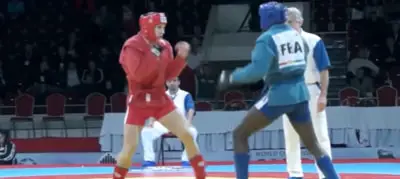
MMA fighters in the biggest organizations are pretty tall for their weight. To find out how exactly tall they are I put together a table where I calculated the average height for each division, using the data for the current top 10 UFC fighters of each of those divisions. Here’s it:
| Weightclass | Height in inches | Height in cm |
| Heavyweight (up to 265 lb; 120.2 kg) | 6 feet 3 3/4″ | 192.5 |
| Light heavyweight (up to 205 lb; 93.0 kg) | 6 feet 3″ | 191.0 |
| Middleweight (up to 185 lb; 83.9 kg) | 6 feet 0 1/4″ | 184.2 |
| Welterweight (up to 170 lb; 77.1 kg) | 5 feet 11 1/4″ | 181.1 |
| Lightweight (up to 155 lb; 70.3 kg) | 5 feet 10 1/4″ | 179.3 |
| Featherweight (up to 145 lb; 65.8 kg) | 5 feet 8 3/4″ | 174.8 |
| Bantamweight (up to 135 lb; 61.2 kg) | 5 feet 6 1/2″ | 168.9 |
| Flyweight (up to 125 lb; 56.7 kg) | 5 feet 5 1/4″ | 166.4 |
The tallest fighter is the heavyweight Alexander Volkov (6’7”) and the shortest fighter fighters are several flyweights and bantamweights who stand 5’4”’tall according to ufcstats.com.
There are 2 problems with that table, though. The first one is that UFC is often making short fighters taller by adding height and their rounding system is flawed. They are rounding to the nearest inch, and because of that many fighters are equally tall according to the UFC.
The correct data is ±1 inch of what the table says (and probably -1 inch for the smaller weight classes – Bantamweight and Flyweight).
But still, on the highest level of MMA fighters are almost as tall as the average kickboxer. That’s mainly because the height is a huge advantage especially when it comes to striking. Taller fighters have naturally a longer range of attack because of their height and long reach (both arm and leg reach).
When it comes to BJJ, longer limbs are also useful because it’s easier to attack for submissions like triangles, D’arce chokes, anaconda chokes, etc.
But that doesn’t mean short fighters don’t have their advantages in stand-up and on the ground.
In the rest of the article, I’ll go in detail on why MMA fighters appear to be so tall for the weight, what advantages tall and short fighters have and what is the connection between height and fighting style.
Why MMA fighters are so tall?
1) Weight Cutting
During training camp and especially the week before the fight, fighters cut a lot of weight. During the camp, they lose weight because of the intense training but the few days before the weigh-ins the intentionally dehydrate themselves to a certain extend, don’t eat much while doing a lot of cardio training so they can make the necessary weight for the division.
After the weigh-ins, they start eating and hydrating themselves again. That way big (and tall) fighters can compete in smaller weight classes and have a size advantage. But since everybody is cutting weight nowadays, it’s more of a disadvantage if you don’t do it.
A normal difference between the weight on the weigh-ins and on the fight night can be 10-13%. But although it’s rare, there are more extreme examples of fighters who cut 16-19% of their total body mass.
For example, the UFC fighter Sodiq Yusuff who competed at featherweight (145 pounds) in his last fight weighed 169.2 pounds on the fight night. That’s almost a 17% difference.
That is one of the reasons MMA fighters appear so tall for their weight – they simply weigh more. We see their fight night version, who is 10-13 or even more percent bigger than their weight class.
Generally cutting weight is very unhealthy. I think that there was a rule that says if the difference in your weight on weigh-ins and on the fight night is more than 10% you can be forced to go compete at the weight class above you.
Other organizations like ONE FC even forbid weight cutting. That’s why their fighters usually don’t look as ripped as UFC or Bellator fighters.
2) Importance of height in MMA
Usually, strikers rely the most on their height and reach advantage when fighting. That allows them to punch and kick their opponents from a distance where they can’t reach them.
Examples for that are fighters such as Anderson Silva, Israel Adesanya, Jon Jones, Alexander Volkov, and others.
Besides the heavyweights, the rest of those types of fighters appear to be skinnier than their opponents. That’s because they have a long frame so if they put on muscle mass they’ll probably be too heavy to compete in a weight class where they have a huge height advantage.
Some fighters are willing to go to the extreme when it comes to cutting weight just to be in a weight class where they have a big range advantage. Examples for that are Conor McGregor when he fought at featherweight and Dan Hooker (6 ft tall) who also fought at featherweight.
Such fighters are very technical and have a good defense. They usually play it smart and don’t get the finish every time but are very hard to deal on the feet. They utilize kicks and straight punches very well and have great distance management.
In the clinch, tall fighters have an advantage because they can push their opponent’s head down and throw knees. They usually have more powerful elbows because of the leverage they have from their long arms.
That’s why they are a target for wrestlers who try to take them to the ground and negate their striking advantage. Having a good takedown defense and footwork is crutial for such fighters.
Advantages of being short in MMA
The examples of short fighters who do well in their weight classes are countless – Daniel Cormier (LHW and HW); Kelvin Gastelum (Middleweight); Robbert Whittaker (MW).
Short fighters are able to put on more muscle mass and still make weight. That makes them more powerful and stronger. Most of the times people with short but more massive arms hit much harder than someone with long but skinny arms. So short fighters usually have the power advantage.
Short fighters usually have much more powerful hooks, uppercuts and body punches.
They are also often faster and have an advantage when it comes to wrestling because they can change levels much quicker and go for their opponents’ legs.
They also have a lower center of gravity which makes them harder to take down from many positions but also allows them to pick their opponents easier and slam them with high-crotch takedown.
While on the ground, tall fighters have much more dangereous trianlge chokes and D’arce chokes, short and stocky fighters are much more at submissions that require more strength – kimuras, americanas, guillitines and neck cranks.
Style
Your body type is the number 1 factor that determines your fighting style. Generally speaking, tall and long people are better kickboxers why short and stocky people are better at wrestling.
There are, of course, short strikers for their weight class (Robber Whittaker) or really tall wrestlers (Jon Jones). But if you are a tall fighter with a wrestling backgorund you abosolutely need to learn to utilize your kicks and straight punches.
The same goes for short strikers. If you are a short person for your weight class but you are have good kickboxing/Muay Thai or general striking chances are you rely munch on your power.
There’s nothing wrong with that but if you also have a quick and good timed double leg, it’ll be much harder for your opponents to defend both your strikes and takedowns.
Mixing up your offense like that is the missing piece of the game of many fighters today.



